Key takeaways:
- Intersectionality in campaigns highlights the diverse identities individuals possess, affecting their experiences and underscoring the need for inclusive approaches in advocacy.
- Privacy advocacy is essential for protecting the rights of marginalized communities, as privacy violations can have severe implications on their access to resources and overall well-being.
- Engaging with diverse perspectives enriches advocacy efforts, making campaigns more effective by acknowledging and addressing unique concerns and experiences.
- Integrating intersectionality faces challenges such as prioritizing certain identities and time constraints, necessitating a commitment to create equitable dialogue and understanding.
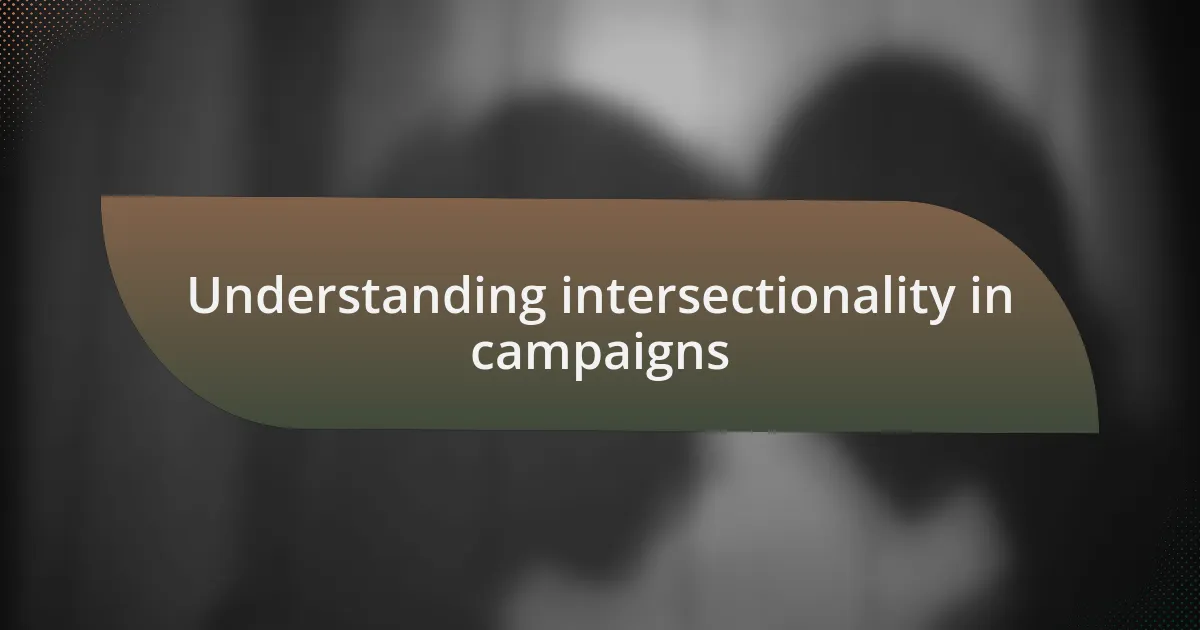
Understanding intersectionality in campaigns
Intersectionality in campaigns is about recognizing that individuals have multiple identities that intersect, influencing their experiences and concerns. I once participated in a privacy advocacy workshop where a speaker shared her story as a Black transgender woman. It struck me how her challenges differed vastly from mine simply because of her unique identity, illustrating that one-size-fits-all approaches in campaigns can leave many voices unheard.
When we consider intersectionality, we must ask ourselves: whose voices are being prioritized? This question always lingers in my mind during campaign discussions. I recall working on a campaign that focused on digital privacy. While we aimed to protect everyone, I realized we hadn’t sufficiently addressed how marginalized communities experience privacy violations differently. The realization was humbling and made me question the depth of our understanding.
Each identity can amplify vulnerabilities, and this interplay should shape our strategies. For instance, when planning campaign materials, incorporating diverse perspectives not only deepens our message but also broadens our reach. I’ve seen campaigns thrive when they actively seek input from those with various experiences. It’s a reminder that to advocate effectively, we must embrace the complexity of people’s lives, recognizing their multifaceted identities.
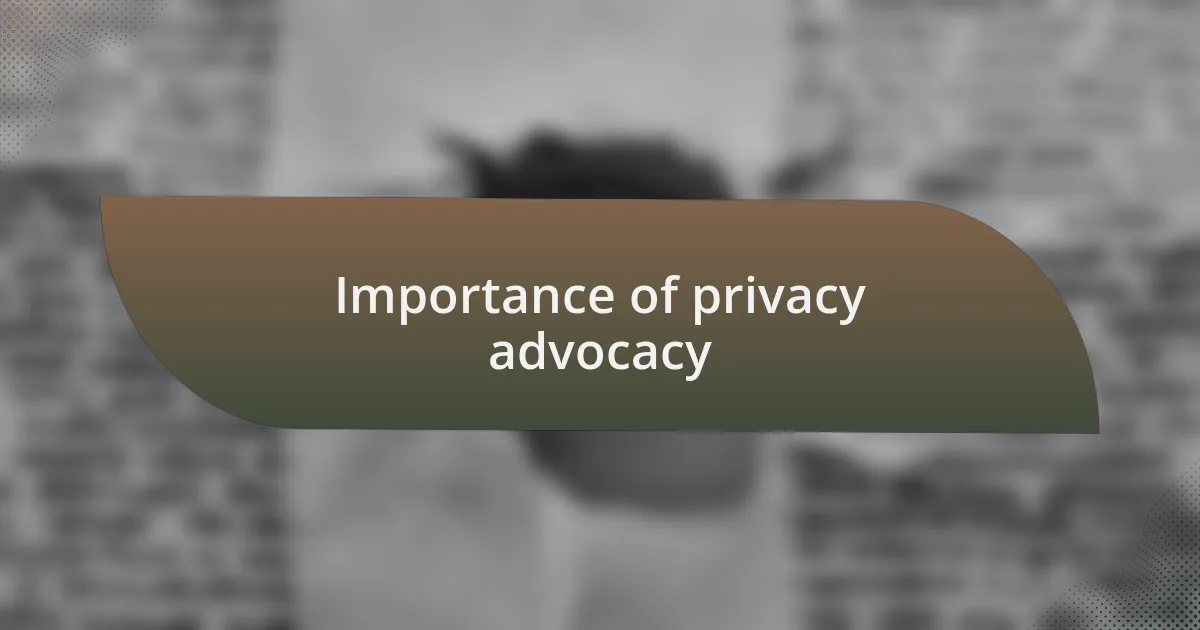
Importance of privacy advocacy
Privacy advocacy is crucial because it ensures that everyone’s rights are respected, especially those from marginalized backgrounds. I remember a local gathering where a community member shared her experience with data breaches that severely impacted her due to her socio-economic status. It hit home for me—how often do we overlook the unique challenges certain individuals face in our push for privacy?
The implications of privacy violations can be devastating, affecting access to resources and opportunities. During one campaign, I learned that a single incident of identity theft led to a cascade of problems for an immigrant family, disrupting their lives in ways I hadn’t anticipated. Can you imagine the fear of being stripped of your identity? It’s these stories that fuel my passion for advocating for robust privacy protections.
Ultimately, privacy advocacy shapes the landscape for equitable treatment. I often reflect on how our digital footprints impact not just ourselves but also our communities. When we stand up for privacy rights, we are directly challenging systemic injustices, making it essential to keep these voices at the forefront of our discussions. Without this focus, we risk creating a fractured approach that fails to address the complexities at play.
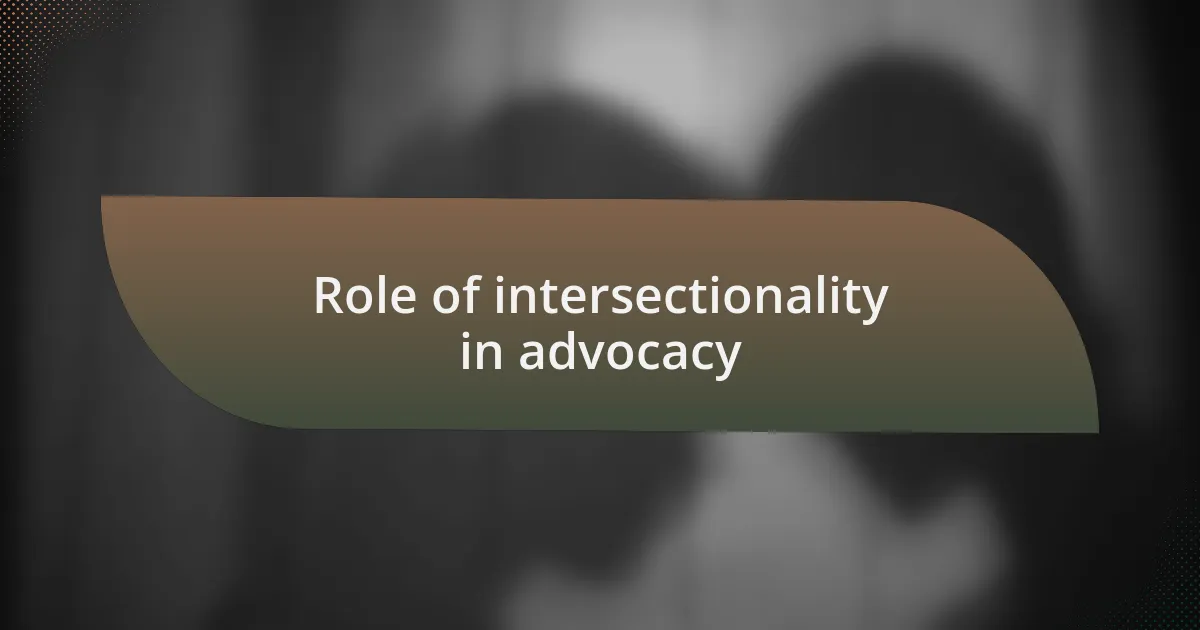
Role of intersectionality in advocacy
Intersectionality plays a pivotal role in advocacy, especially when it comes to privacy. I once attended a workshop where we discussed how different identities intersect—like race, gender, and socio-economic status—shaping individuals’ experiences with privacy violations. It was eye-opening to realize how a single data leak could have far-reaching impacts, differing vastly between a privileged tech-savvy individual and someone from a marginalized community struggling to navigate the digital world.
In my own advocacy work, I’ve seen firsthand how ignoring intersectional factors can lead to ineffective campaigns. For instance, during a privacy rights initiative, a colleague shared her struggles as a person with disabilities. Her unique challenges in accessing digital resources often went unnoticed in broader discussions. This made me question—how can we create truly inclusive campaigns if we don’t actively seek out and amplify these diverse perspectives?
Ultimately, embracing intersectionality enriches our advocacy strategies, allowing us to address the nuanced experiences of various communities. I remember a campaign where we deliberately included voices from underrepresented groups, and the results were profound. It highlighted an array of unique concerns and solutions that we would have otherwise missed. Isn’t it fascinating how much more powerful our message becomes when we weave together the stories of those often left unheard?
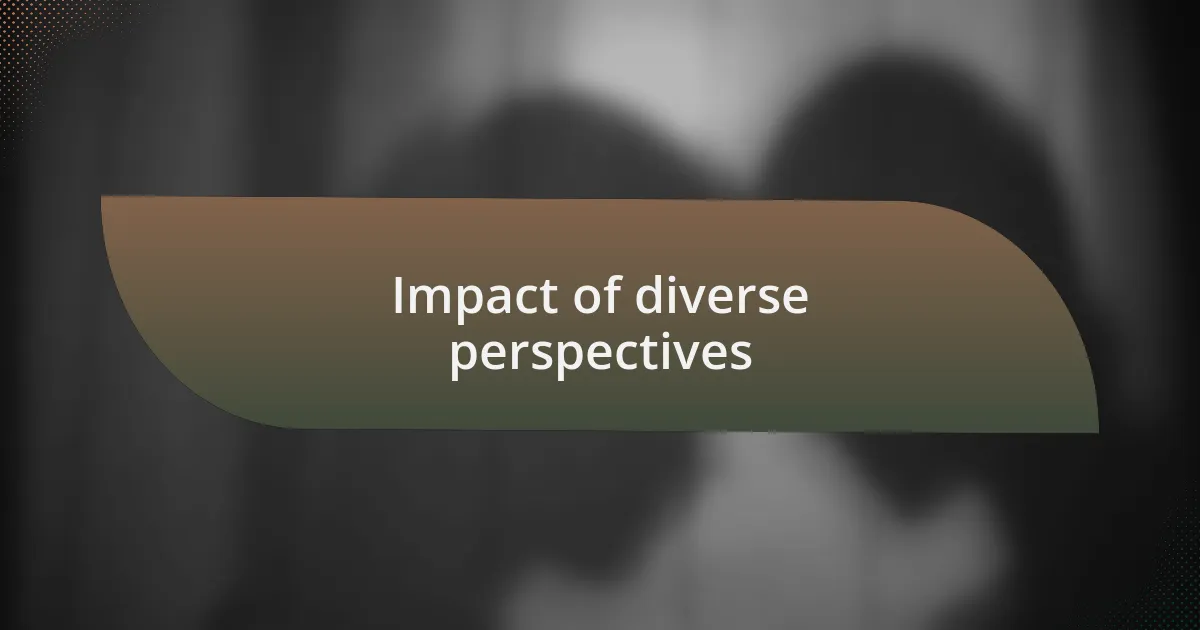
Impact of diverse perspectives
Engaging with diverse perspectives profoundly shapes our understanding of privacy issues. I recall collaborating with activists from different backgrounds during a campaign strategy session. Their insights illuminated how cultural context profoundly impacts perceptions of privacy. For example, a community that has faced historical surveillance might view privacy not just as an individual right but as a collective necessity. This dialogue not only broadened our approach but also deepened my appreciation for the varied experiences that inform our shared narrative.
The richness of these diverse viewpoints truly enhances the effectiveness of our campaigns. I remember when we adapted our materials to include translations and culturally relevant references after consulting with community leaders. The response was overwhelming—people felt seen and understood. It made me wonder, what other insights are we missing by sticking to a one-size-fits-all approach? This shift has taught me that when diverse voices are heard, our advocacy resonates on a deeper level, fostering genuine connections.
Seeing the significant impact of inclusive dialogue reinforces my belief in its necessity. During a recent campaign launch, we featured stories from individuals across various spectrums—race, gender identity, and socio-economic status. This not only enriched our messaging but also created an emotional bridge with our audience. It’s inspiring to think that each unique story can fuel a broader movement. Isn’t that the essence of advocacy? To unite our voices, shaping a fight for privacy that resonates with everyone, especially those often marginalized in these conversations?
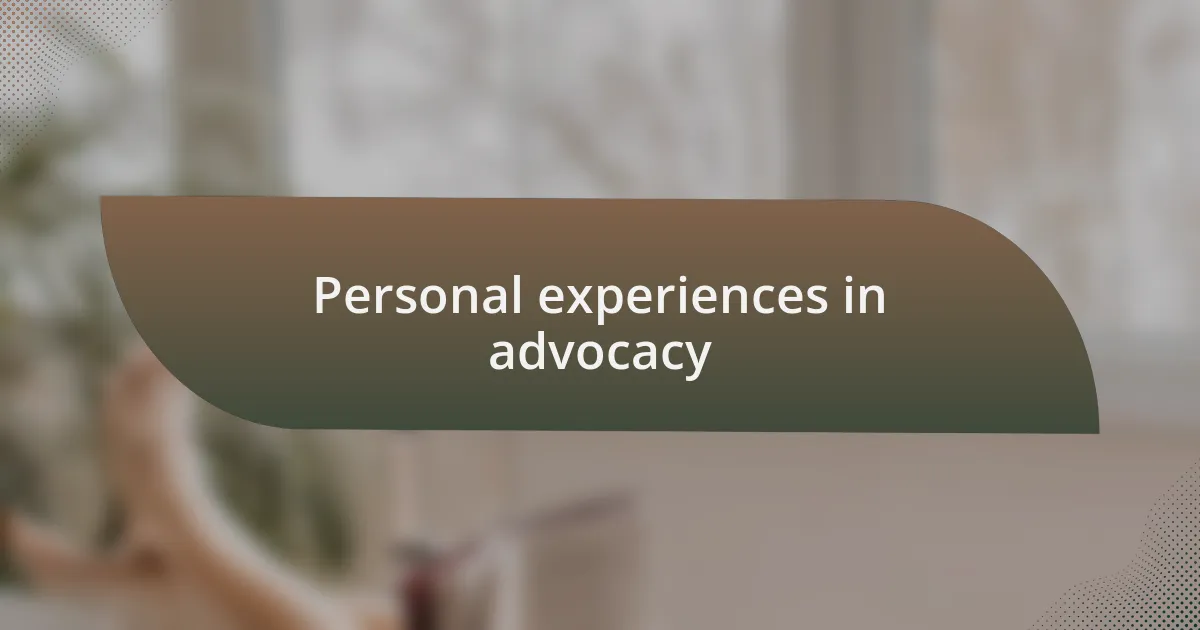
Personal experiences in advocacy
Advocacy has always been a personal journey for me, rooted in my own experiences. I recall attending a local forum where a community member shared how their culture uniquely shapes their understanding of privacy. Listening to their story made me reflect on my own upbringing and how different environments can skew the perception of privacy rights. It struck me: Have I truly considered how my background filters my views? That moment spurred a desire to dive deeper, to advocate not just from my lens but through the eyes of others.
One time, I collaborated on a privacy workshop designed specifically for marginalized communities. The energy in the room was palpable as we shared our stories and challenges. Seeing participants nodding in recognition as they reflected on their own privacy struggles created a powerful sense of solidarity. This experience taught me the importance of creating safe spaces for dialogue—spaces where people feel their vulnerabilities are acknowledged. How often do we provide platforms for these crucial conversations?
In another instance, I encountered a young activist whose experience with digital surveillance was both enlightening and heartbreaking. Their account of feeling constantly watched resonated on a deeply emotional level for everyone present. I couldn’t help but think about how vital it is to amplify such voices. Each story adds layers to our campaign, unearthing facets of advocacy we often overlook. What if we committed to not only listening but also amplifying these narratives? Embracing our collective stories can redefine the very fabric of our advocacy work.
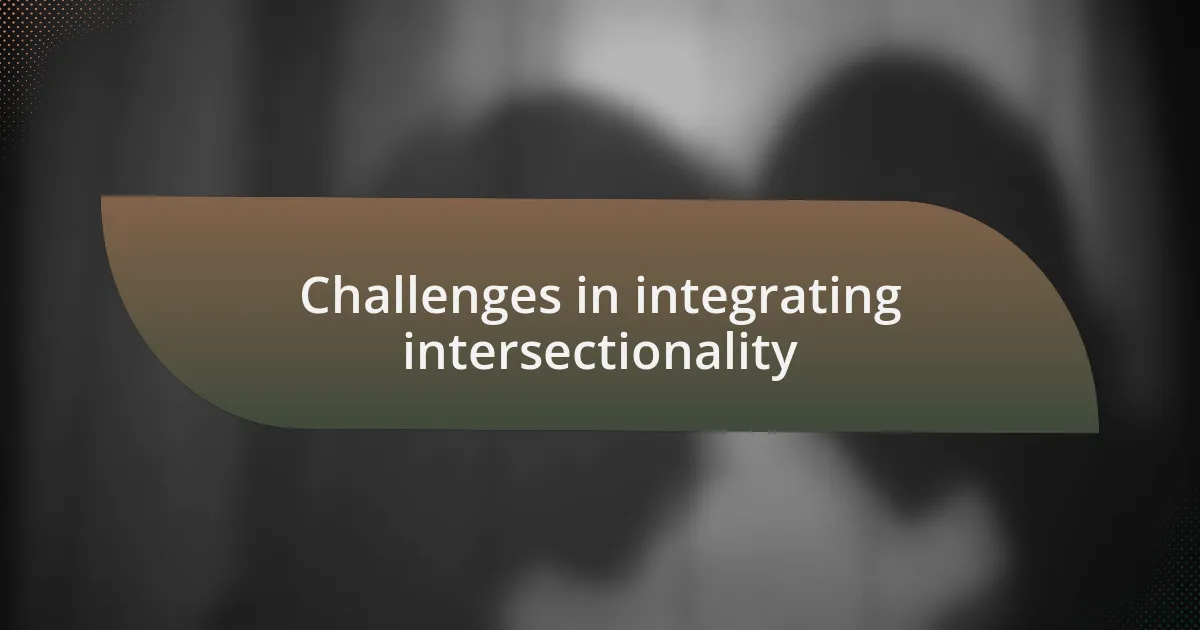
Challenges in integrating intersectionality
As I’ve engaged with various advocacy groups, I’ve noticed a common challenge: the tendency to prioritize certain identities over others. For instance, while organizing a campaign focused on privacy laws, I struggled to address the unique concerns of individuals with disabilities adequately. How do we ensure that every voice is heard when some groups consistently dominate the narrative?
One event that remains etched in my memory was a community roundtable where voices from different backgrounds clashed. Some participants felt their experiences of digital privacy were overshadowed by broader issues others prioritized, like economic inequality or systemic racism. This moment made me realize that even well-meaning efforts could miss the mark; how can we genuinely integrate all perspectives when we sometimes fail to create equitable spaces for dialogue?
I’ve also observed that time constraints can be a significant barrier to fully embracing intersectionality. In one project, our team rushed through discussions about different identities and their privacy concerns because we were pressed to meet deadlines. This left me wondering—what do we lose when expediency takes precedence over thorough understanding? Addressing these conflicts requires not only commitment but also a willingness to slow down and ensure everyone feels valued in the conversation.
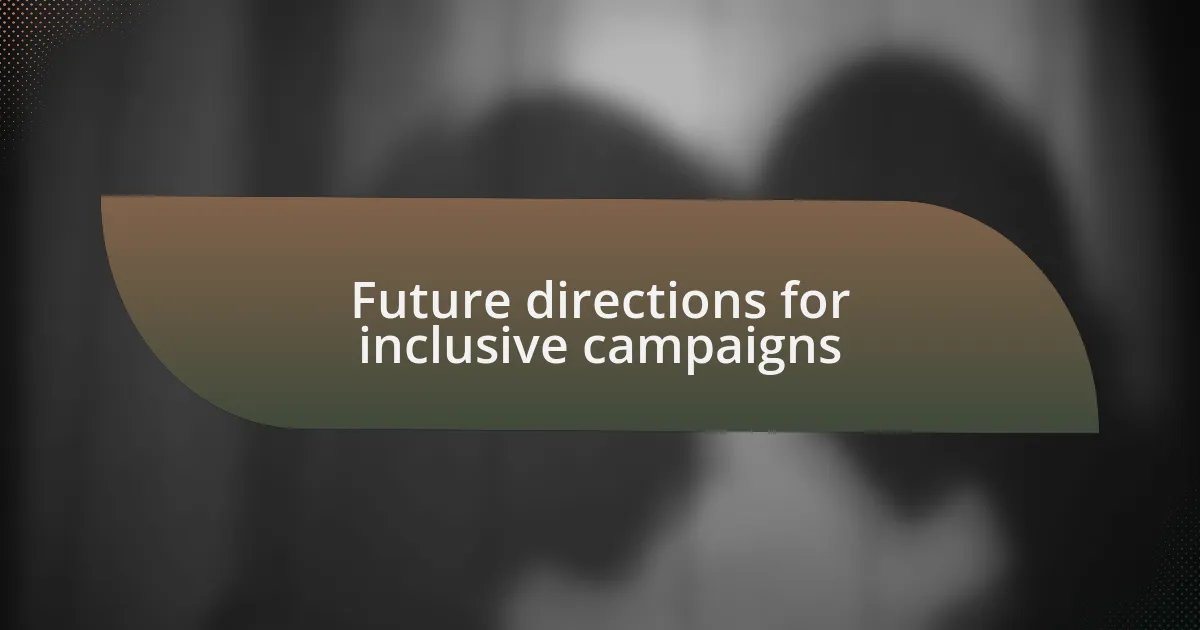
Future directions for inclusive campaigns
In envisioning inclusive campaigns for the future, I believe we need to shift our focus towards collaborative storytelling. I remember a project where we invited community members to share their own digital privacy experiences. The richness of those diverse narratives not only highlighted intersectional concerns but also forged genuine connections among participants. So, how can we ensure that such storytelling becomes a standard practice in our advocacy work?
Moreover, engaging with marginalized voices demands ongoing education and empathy from campaign organizers. I often find myself reflecting on how privileged my own background is when discussing these issues, and it compels me to seek out perspectives that challenge my own understanding. As campaigners, how can we cultivate a culture of learning that allows us to grow alongside the communities we aim to represent?
Lastly, it’s crucial to evaluate our success metrics. I’ve been involved in campaigns that focused solely on quantitative results, which often overlooked the qualitative experiences of individuals. This makes me wonder—what if we prioritized measuring the actual impact of our initiatives on diverse communities instead? A shift towards a more nuanced evaluation can provide richer insights and encourage deeper inclusivity in future campaigns.